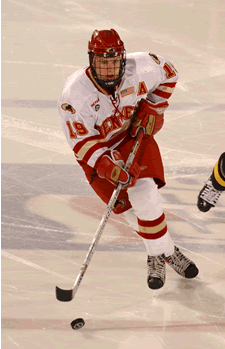June
20, 2006
INCH's
Pre-NHL Entry Draft Notes
 |
| Why
would former Denver forward Connor James be featured
prominently in INCH's notes for the 2006 NHL Entry Draft?
You'll have to read the entire article to find out. |
Gophers
Going, Going, Gone: It’s possible, though
not probable, that defenseman Erik Johnson and forward Phil
Kessel – Minnesota Gopher teammates-to-be in 2006-07
– could be the first and second players chosen in
this week’s draft. On only one other occasion have
teammates gone 1-2 in the draft’s first round. That
was in 1969, when Montreal had a special exemption to select
the first two French-Canadian players. The Habs took Rejean
Houle and Marc Tardif from the Montreal Junior Canadiens.
A
First For A First: Johnson, the consensus pick
to go to St. Louis with the first overall selection, would
become the first defenseman with college hockey ties to
be chosen No. 1. In fact, no college rearguard has gone
higher than third overall – Michigan’s Jack
Johnson achieved that distinction when he was nabbed by
Carolina in last year’s draft.
The
Bloomington, Minn., native wouldn’t be the first U.S.-born
blueliner to become the first overall choice, however. Rhode
Island product Bryan Berard was a member of the Ontario
Hockey League’s Detroit Whalers when Ottawa tabbed
him with the top pick in 1995.
Maize
and Blue Streak: The University of Michigan’s
streak of having a player taken in the draft’s first
round is likely to reach six years in a row in 2006. Defensemen
Mark Mitera, who's between his freshman and sophomore seasons,
or Chris Summers, who’ll be a freshman for the Wolverines
this fall, are both considered first-round prospects. Throw
out the 2000 draft, and at least one player with ties to
Red Berenson’s program has gone in the first round
each year since 1998.
Should
Michigan fail to see one of its players go in the first
round this season, Minnesota will have the top active streak
of years with a first-round selection. With Johnson and
Kessel top-10 locks, the Gophers’ run of first-rounders
should reach five years in a row.
Exponential
Growth: In the five drafts that have occurred in
this decade, there have been more than twice the number
of first-round college picks (41) as there were in the entire
decade of the ‘90s (18). Taking that statistic one
step further, in the last three drafts, 24 collegians have
been selected in the first round.
Front
Office Space: Maybe more collegians (or players
about to become collegians) are being chosen in the draft
because the guys heading up the brain trusts of NHL teams
are former collegians. The recent hirings of Peter Chiarelli
(Boston), Ray Shero (Pittsburgh) and Neil Smith (New York
Islanders) brings the number of ex-NCAA skaters who are
now NHL general managers to 13. The complete list: